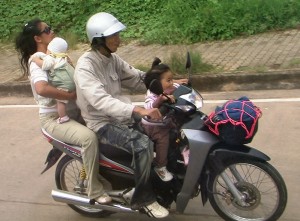Thailand Traffic Innovation
For the last 3 weeks I’ve been in Thailand. As I always do I look for innovations or different approaches to innovation. Thailand is a very decentralized nation. This seems to contradict the extreme nationalism but things here don’t get done on a centralized basis. The bulk of activity happens at the personal and family level.
Any place you go there is someone selling something. Go to the park and there is someone renting mats to sit on the grass. Walk down the sidewalk and there are hundreds of food carts and other miscellaneous things for sale. And on the roads there is extreme variety. Bicycles, push carts, motorcycles, tuk tuks, cars, trucks converted in to buses, mini-buses, full sized buses and trucks. You might even see an elephant.
It’s well known that Bangkok traffic is some of the worst in the world. It took me 4 hours to ride a bus 6 miles (12 km). They don’t even bother having schedules because it is impossible for a bus or a car to know how long it will take to get anywhere in Bangkok. This is a huge drag on productivity. But rather than complain, Thais find their own individual solution.
If you need to get someplace in Bangkok the fastest way is a motorbike. There are motorbike taxis and entire families riding a single motorbike. Motorbikes ignore most traffic laws and all concepts of safe riding. Helmets are required by law but seldom worn. And if there is any space at all the motorbike driver will race into it. This leads to hoards of motorbikes collecting at front of traffic revving their engines at the light resembling the start of a race.My second home is Chicago and even though Chicago has nearly double the population density of Bangkok traffic runs very smoothly. Chicago’s traffic problems are mainly during rush hour on the expressways leading into or out of the city and surrounding sports stadiums before and after a game. Chicago has a subway and elevated, and buses that show up every ten minutes and you don’t have to negotiate the price of riding a taxi. Chicago is very organized and centrally controlled.
Am I suggesting Bangkok become more centralized? No. The centralized control is not what makes Chicago work. It’s the variety of options available to the individual. But didn’t I say that Bangkok has more options? Actually no. Even though there are many different types of vehicles they all have to travel the same path. The only way to travel through Bangkok is the city streets. If the roads are crowded in Chicago you can take the subway or light rail. You can drive on the city streets or the free way or the toll-expressway. And the buses have dedicated lanes.
The motorbikes in Bangkok have found an alternative road, the space between cars. When cars, trucks and buses are stopped the motorbikes drive between. Motorbikes don’t compete for the roads with the larger vehicles. The motorbikes are able to use an over looked resource, the small space between vehicles.
The motorbikes also follow another important aspect of successful innovation. An individual can easily purchase a motorbike. For the price of one months rent you can buy a motorbike. It does not require a large investment and switching to motorbikes can be done one person at a time. Incremental investment but huge gains for the person choosing a motorbike.
Bangkok has one elevated train called the Sky Way and a second Sky Way line under construction. The Sky Way is the nicest train I’ve every seen. It greatly helps those who want to travel along the line but it doesn’t do much good for others. The Sky Way is extremely expensive to build and doesn’t help anyone until the whole thing is completed. This is high cost and high risk.
One of the reasons the personal computer revolution and now the Internet has been so successful for innovation is nearly anyone can try something. The barriers to entry are very low and the rewards can be extremely high. Decentralized or at least distributed systems are much more likely to result in successful innovation. The “moon mission” approach usually fails. One of the big benefits of Predictive Innovation Method is it reveals all the alternatives. This allows you to build towards a large end goal but do it with small and progressively successful steps. That reduces risk, maximizes profits and eliminates the threat of competition.





 Predictive Innovation Training
Predictive Innovation Training Predictive Innovation: Core Skills Book
Predictive Innovation: Core Skills Book RoundSquareTriangle.com
RoundSquareTriangle.com
Interesting observations. Much appreciated. / Per